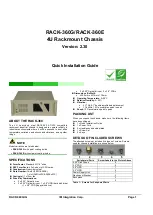
Shelf Manager CLI
Fortinet Technologies Inc.
Setting alarm output
Use minor, major and critical to set the corresponding alarm output. These actions are cumulative; that is, after the
commands
clia alarm minor
and
clia alarm major
, both minor and major alarms will be set.
board
clia board [-v] [<physical-slot-address>]
Enter
clia board
without any parameters to view information about each IPM controller and about each additional
FRU controlled by these controllers.
This command is different from most of the rest of the commands because its works with ATCA boards and takes as
arguments physical slot numbers, instead of IPM controller addresses and FRU device IDs.
This makes this command easier to use when boards may not include an IPM controller and therefore, are not easily
addressable using the IPMB address – FRU device ID pair.
Viewing information about a board
Enter the following command to view information about a particular board, for example the board in physical slot 11
(logical slot 8, IPMB address 90):
# clia board 11
Pigeon Point Shelf Manager Command Line Interpreter
Physical Slot # 11
90: Entity: (0xa0, 0x60) Maximum FRU device ID: 0x00
PICMG Version 2.1
Hot Swap State: M4 (Active), Previous: M3 (Activation In Process), Last State Change Cause:
Normal State
Change (0x0)
90: FRU # 0
Entity: (0xa0, 0x60)
Hot Swap State: M4 (Active), Previous: M3 (Activation In Process), Last State Change Cause:
Normal State
Change (0x0)
Device ID String: "FG5005A"
Add
–v
to the command to display more information (verbose).
The command output includes the hot swap state. M4 is the normal hot swap state.
The following table lists the FRU states defined in the PICMG 3.0 specification as follows:
PICMG FRU states
FRU state
Description
M0
Not Installed
FortiGate-5144C 6.2.3 Chassis Guide
46












































